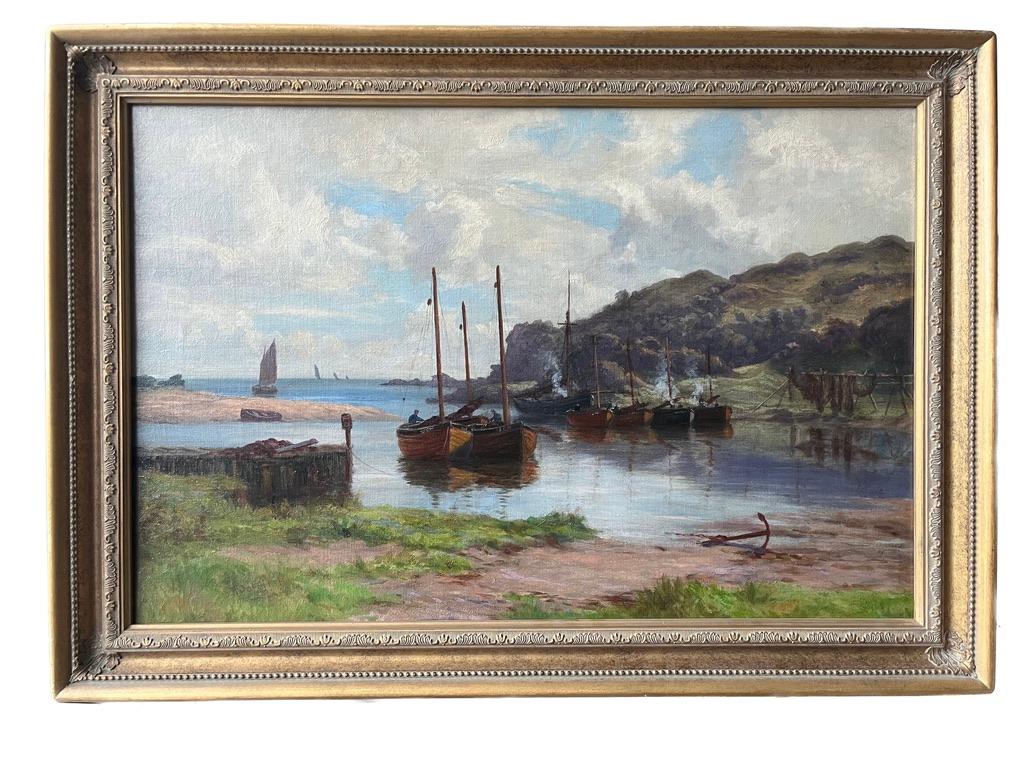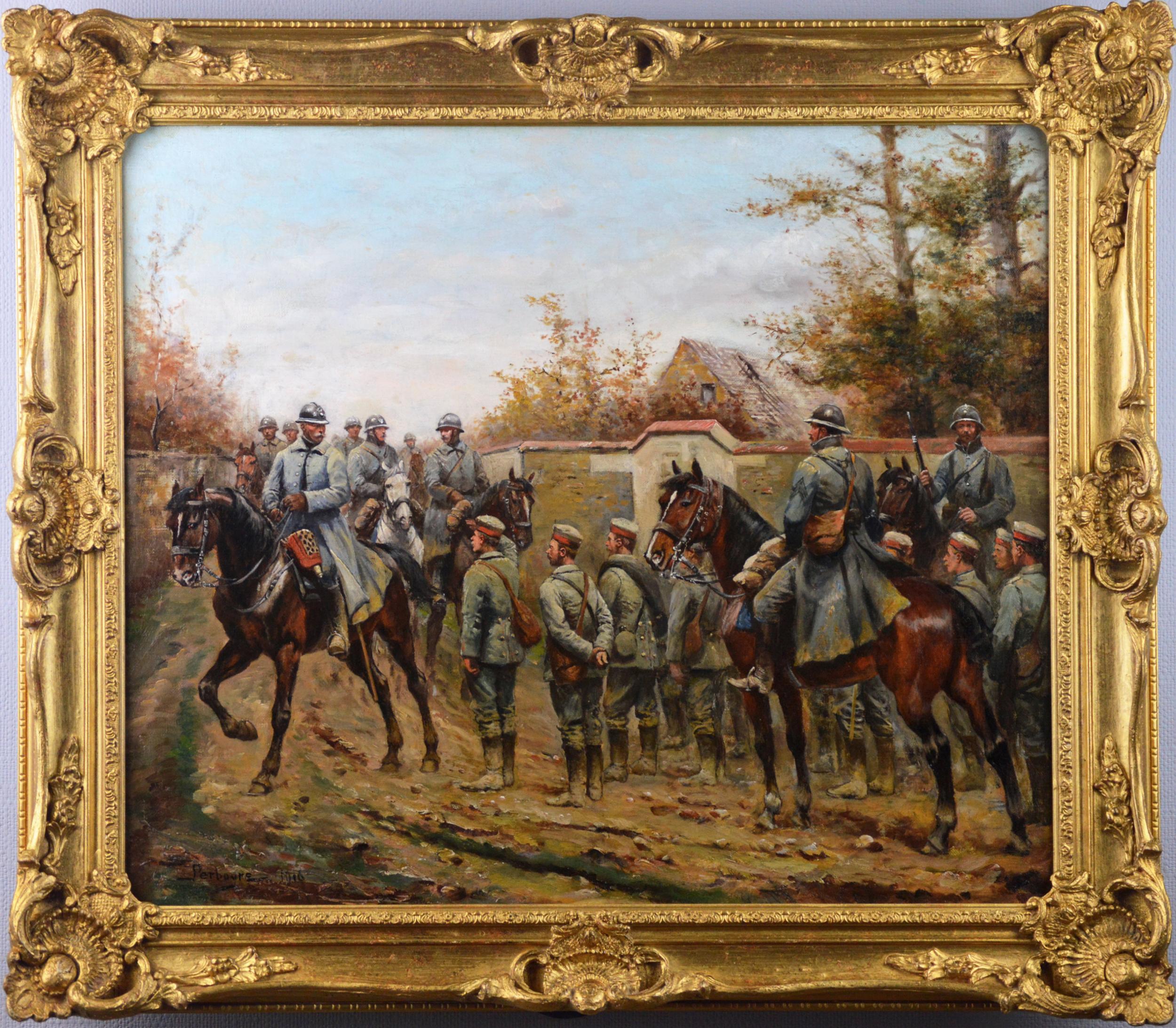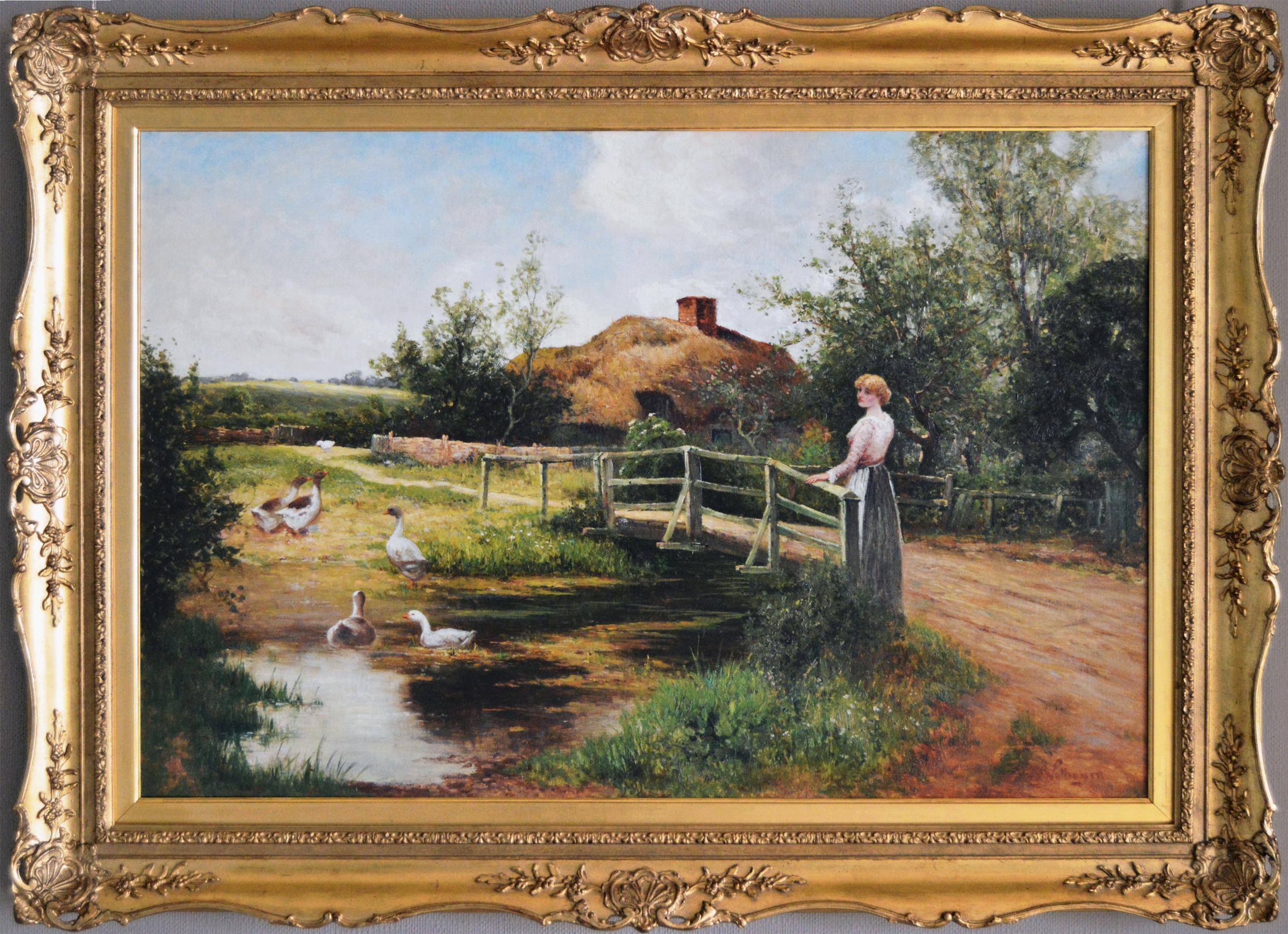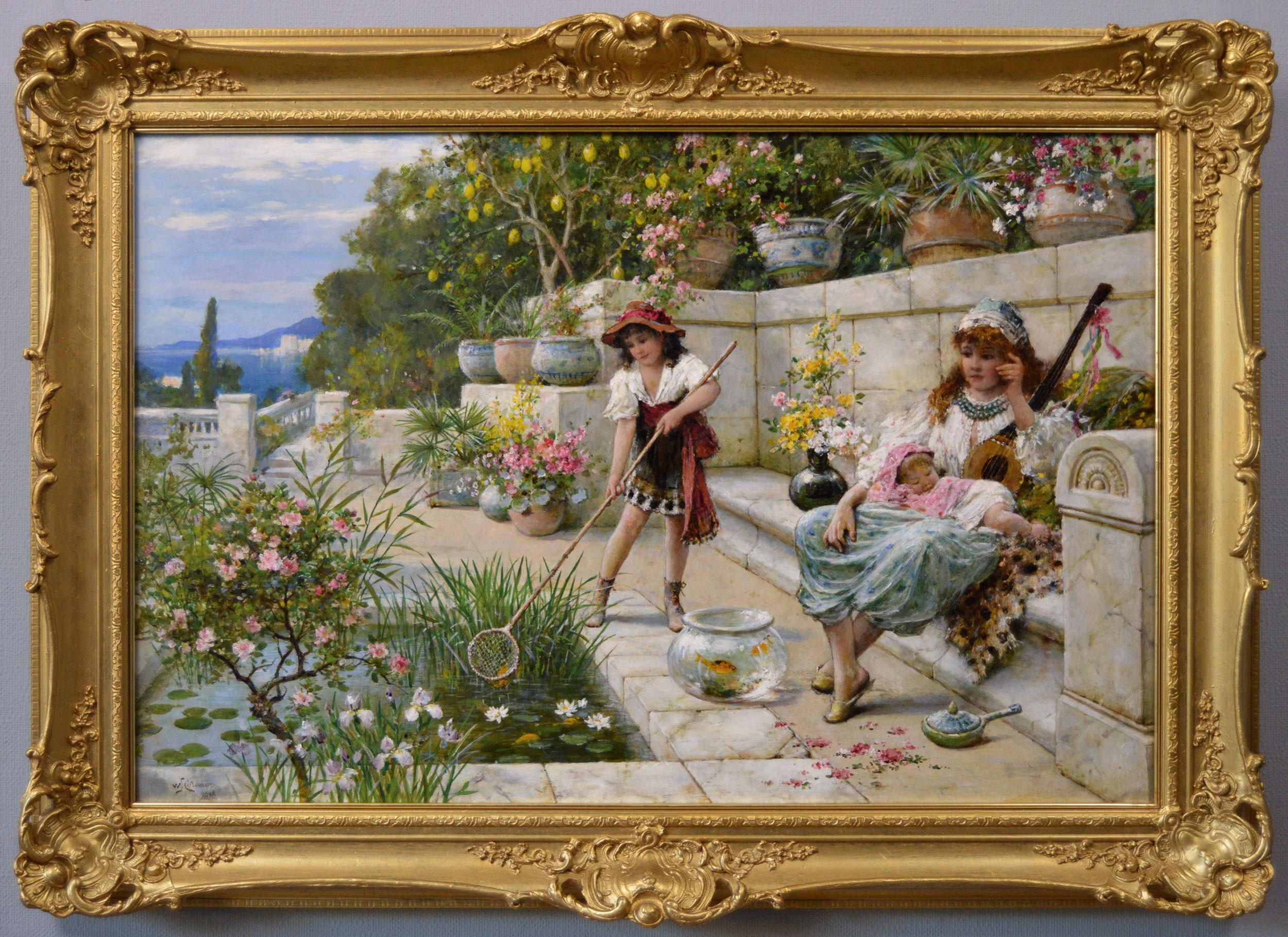Items Similar to Ezekiel in the Valley of Dry Bones
Want more images or videos?
Request additional images or videos from the seller
1 of 6
Philip Burne-JonesEzekiel in the Valley of Dry Bones
About the Item
Provenance:
Christie’s, London, 3 March 1922, lot 46 (with The Tower of Babel);
James Nicoll
Private Collection
Sotheby’s, London, 29 March 1983, lot 157
Private Collection, New York (1983–present)
Exhibited:
The New Gallery, 1888.
Works by Sir Philip Burne-Jones, Bt., The Dowdeswell Galleries, London, April – May 1914.
Literature:
“The Pictures of 1888,” Pall Mall Gazette Extra, no. 41 (1888), p. 77, ill.
Cosmo Monkhouse, “The New Gallery; II,” The Academy, vol. 3, no. 849 (1888), p. 419.
Martin Harrison and Bill Waters, Burne-Jones, London, 1973, p. 180.
Philip Burne-Jones was the only son of Sir Edward Coley Burne-Jones and, like his father, painted from an early age. He was educated at Marlborough and at University College, Oxford, but had little academic success. Philip began to exhibit at the Grosvenor Gallery in 1886 but preferred to show at the New Gallery from its opening two years later, where the present painting first appeared. He produced a few literary pictures at the beginning of his career but specialized in landscapes and portraits. Harrison and Waters have written that Philip “had a talent for portraiture and landscape, and like George Howard, infrequently ventured into imaginative or figure work. Working mostly in gouache or watercolour, once again like Howard, his style could never be confused with his father’s though it approaches it in Ezekiel in the Valley of Dry Bones, which was exhibited at the New Gallery in 1888.”
Philip’s portraits of his father, his uncle Rudyard Kipling, and Sir Edward J. Poynter hang in the National Portrait Gallery, but few of his works are in public collections. His most celebrated painting in his day was The Vampire, an 1897 canvas that was said to inspire a poem by Kipling; its present location is unknown.
Ezekiel in the Valley of Dry Bones is one of the artist’s finest and most evocative paintings. The subject is taken from Ezekiel 37:1-10 (with special reference to 37:2) and is a remarkable portrayal of the Biblical scene. Here Philip follows in the footsteps of his father, with a composition at once mysterious and romantic, and alimited palette here punctuated by the brilliant orange spot of the setting sun. Writing at the time of the New Gallery exhibition, Cosmo Monkhouse described Philip Burne-Jones’s Ezekiel as “the most impressive picture he has yet exhibited.”
When sold in 1922, Ezekiel in the Valley of Dry Bones was paired with another painting by the artist, The Tower of Babel. That work, dated 1889, is at present lost, having last appeared at auction at Sotheby’s, Belgravia, 6 December 1977, lot 100.
- Creator:Philip Burne-Jones (1861 - 1926, British)
- Dimensions:Height: 23 in (58.42 cm)Width: 18 in (45.72 cm)
- Medium:
- Movement & Style:
- Period:
- Condition:
- Gallery Location:New York, NY
- Reference Number:1stDibs: LU1021074663

About the Seller
5.0
Recognized Seller
These prestigious sellers are industry leaders and represent the highest echelon for item quality and design.
Established in 1997
1stDibs seller since 2012
17 sales on 1stDibs
Typical response time: 11 hours
- ShippingRetrieving quote...Ships From: New York, NY
- Return PolicyThis item cannot be returned.
More From This SellerView All
- Two Scenes of Diana and Actaeon (a pair)By Giovanni Battista ViolaLocated in New York, NYProvenance: Robert L. and Bertina Suida Manning, New York, until 1996 Private Collection, USA Giovanni Battista Viola was born in Bologna a...Category
17th Century Baroque Landscape Paintings
MaterialsCopper
- Head of an AngelLocated in New York, NYProcaccini was born in Bologna, but his family moved to Milan when the artist was eleven years old. His artistic education was evidently familial— from his father Ercole and his elder brothers Camillo and Carlo Antonio, all painters—but his career began as a sculptor, and at an early age: his first known commission, a sculpted saint for the Duomo of Milan, came when he was only seventeen years old. Procaccini’s earliest documented painting, the Pietà for the Church of Santa Maria presso San Celso in Milan, was completed by 1604. By this time the artist had made the trip to Parma recorded by his biographers, where he studied Correggio, Mazzola Bedoli, and especially Parmigianino; reflections of their work are apparent throughout Procaccini's career. As Dr. Hugh Brigstocke has recently indicated, the present oil sketch is preparatory for the figure of the angel seen between the heads of the Virgin and St. Charles Borrommeo in Procaccini's altarpiece in the Church of Santa Afra in Brescia (ill. in Il Seicento Lombardo; Catalogo dei dipinti e delle sculture, exh. cat. Milan 1973, no. 98, pl. 113). As such it is the only known oil sketch of Procaccini's that can be directly connected with an extant altarpiece. The finished canvas, The Virgin and Child with Saints Charles Borrommeo and Latino with Angels, remains in the church for which it was painted; it is one of the most significant works of Procaccini's maturity and is generally dated after the artist's trip to Genoa in 1618. The Head of an Angel is an immediate study, no doubt taken from life, but one stylistically suffused with strong echoes of Correggio and Leonardo. Luigi Lanzi, writing of the completed altarpiece in 1796, specifically commented on Procaccini's indebtedness to Correggio (as well as the expressions of the angels) here: “Di Giulio Cesare...Category
17th Century Old Masters Figurative Paintings
MaterialsCanvas, Paper, Oil
- Joseph and Potiphar's WifeLocated in New York, NYProvenance: Palazzo Pisani at San Stefano, Venice Mrs. F. Craighead (possibly Mrs. Fay Stinson Craighead, Evansville, Indiana) Sale, Sotheby Parke Bernet, New York, 7 June 1978, lot 310, as Bonifazio Veronese Daniel M. Friedenberg, New York, until 2011; and by descent to: Russell Friedenberg, until 2014 Literature: Giuseppe Pavanello, Gli Inventari di Pietro Edwards nella Biblioteca del Seminario Patriarcale di Venezia, Venice 2006, pp. 132, 140, as no. 10 in Pietro Edwards’ inventory of the Palazzo Pisani: “Giuseppe che fugge dalla moglie di Pitifarre” by Bonifacio Veronese. Philip Cottrell and Peter Humfrey, Bonifacio de’ Pitati, (forthcoming), cat. no. 166h. Antonio Palma is the least well-known member of the illustrious Palma family of Venetian painters of the 16th century. He was the nephew of Jacopo Palma—Palma il Vecchio—and upon his uncle’s death in 1528, he began to work with Palma Vecchio’s principal student and the inheritor of the elder artist’s studio, Bonifazio de’ Pitati (Bonifazio Veronese). Antonio worked with Bonifazio as his principal assistant and right-hand man until Bonifazio’s death in 1553, after which he continued his independent career. He married a niece of his master, and their second son, Jacopo, born in 1648, would achieve fame as Palma il Giovane...Category
16th Century Renaissance Figurative Paintings
MaterialsCanvas, Oil
- Three AngelsBy Domenico Piola the ElderLocated in New York, NYProvenance: Robert L. and Bertina Suida Manning, New York, until 1996 Private Collection, USA One of the leading artists in Genoa during the second half of the seventeenth century, Domenico Piola came from a successful family of artists, renowned for their many illusionistic ceiling programs throughout Genoese churches and palaces. A prolific draughtsman and painter, Domenico oversaw an extremely productive studio. In addition to his collaborations with numerous other artists, Domenico also provided many designs for book illustrations and prints that circulated throughout Europe, earning him international exposure and high acclaim in his own day. As Dr. Anna Orlando has indicated (written communication), the present work is an early work by Piola, datable from the late 1640s. At this time the young artist came strongly under the influence of Castiglione and Valerio Castello, while admiring the works of Giulio Cesare Procaccini. Piola’s works from this period are exuberant and fluid, and the artist’s love of portraying children is evident from the angels and putti that populate both his altarpieces and more intimate paintings. The present work depicts three angels...Category
17th Century Baroque Figurative Paintings
MaterialsCanvas, Oil
- OrientaleBy Henri Fantin-LatourLocated in New York, NYSigned, lower right: Fantin Provenance: Gustave Tempelaere (1840–1904), Paris; possibly by descent to his son: Julien Tempelaere (1876–1961) and with F. & J. Tempelaere, Paris, prob...Category
1890s Romantic Figurative Paintings
MaterialsCanvas, Paper, Oil
- An Architectural Capriccio with the Preaching of an ApostleBy Giovanni Paolo PaniniLocated in New York, NYProvenance: Santambrogio Antichità, Milan; sold, 2007 to: Filippo Pernisa, Milan; by whom sold, 2010, to: Private Collection, Melide, Switzerland De Primi Fine Art, Lugano, Switzerland; from whom acquired, 2011 by: Private Collection, Connecticut (2011-present) Literature: Ferdinando Arisi, “Ancora sui dipinti giovanili del Panini,” Strenna Piacentina (Piacenza, 2009): pp. 48, 57, 65, fig. 31, as by Panini Ferdinando Arisi, “Panini o Ghisolfi o Carlieri? A proposito dei dipinti giovanili,” Strenna Piacentina, (Piacenza, 2010), pp. 100, 105, 116, fig. 101, as an early work by Panini, a variant of Panini’s painting in the Museo Cristiano, Esztergom, Hungary. This architectural capriccio is one of the earliest paintings by Giovanni Paolo Panini, the preeminent painter of vedute and capricci in 18th-century Rome. The attribution to Panini has been endorsed by Ferdinando Arisi, and a recent cleaning of the painting revealed the artist’s signature in the lower right. Like many of his fellow painters working in Rome during his day, Panini was not a native of the Eternal City. He first trained as a painter and stage designer in his hometown of Piacenza and moved to Rome at the age of 20 in November 1711 to study figure painting. Panini joined the workshop of Benedetto Luti (1666-1724) and from 1712 was living on the Piazza Farnese. Panini, like many before and after him, was spellbound by Rome and its classical past. He remained in the city for the rest of his career, specializing in depicting Rome’s most important monuments, as well as creating picturesque scenes like this one that evoked the city’s ancient splendor. The 18th century art historian Lione Pascoli, who likely knew Panini personally, records in his 1730 biography of the artist that when Panini came to Rome, he was already “an excellent master and a distinguished painter of perspective, landscape, and architecture.” Panini’s earliest works from this period still show the evidence of his artistic formation in Piacenza, especially the influence of the view painter Giovanni Ghisolfi (1623-1683). However, they were also clearly shaped by his contact in Rome with the architectural capricci of Alberto Carlieri...Category
18th Century Old Masters Figurative Paintings
MaterialsCanvas, Oil
You May Also Like
- Victorian landscape painting of the River Thames with horses wateringBy Edwin Henry BoddingtonLocated in Harkstead, GBA very atmospheric scene of a horse and cart crossing the river Wey (a tributary of the river Thames) under a beautiful twilight sky. There is wonderful detail and light with the ar...Category
19th Century Victorian Landscape Paintings
MaterialsOil, Canvas
- Victorian landscape painting of Scottish fishing boats moored in a bayLocated in Harkstead, GBA very tranquil scene of fishing boats moored in harbour with a sunlit sea beyond. Painted with a most attractive palette of blues and greens and with a pleasing composition that le...Category
19th Century Victorian Landscape Paintings
MaterialsOil, Canvas
- Military WW1 oil painting of French & German SoldiersBy Paul Emile Léon PerboyreLocated in Moreton-In-Marsh, GloucestershirePaul-Emile Perboyre French, (1851-1929) The Surrender Oil on canvas, signed & dated 1916 Image size: 20.5 inches x 25 inches Size including frame: 26.25 inches x 30.75 inches Paul-E...Category
Early 20th Century Victorian Figurative Paintings
MaterialsOil, Canvas
- 19th Century seascape oil painting of Penzance harbour, CornwallBy William Edward WebbLocated in Moreton-In-Marsh, GloucestershireWilliam Edward Webb British, (1862-1903) Penzance Harbour Oil on canvas, signed Image size: 29 inches x 45.5 inches Size including frame: 38 inches x 54.5 inches A pleasing coastal painting of Penzance Harbour at low tide by William Edward Webb. In the foreground, a fisherman sells his catch to a woman and her daughter, whilst figures in horses and carts wait for others to unload their boats. William Edward Webb was born in Cheltenham, Gloucestershire in 1862 to William Benjamin Webb and Ellen Butler. His father was a printer and an artist and it is highly likely he received tuition from him. Following the death of his mother, his father remarried and moved the family to Manchester sometime after 1871. By the 1880’s, Webb had started working as an artist and later set up a studio at 30 Exchange Buildings in Manchester. He began exhibiting at the Manchester City Art Gallery from 1890, where he showed more than 60 paintings during his lifetime. He also exhibited at the Royal Academy and Walker Art Gallery Liverpool from 1892. He married Clara Foster in 1899 and the couple lived at 1 Sylvan Grove, Chorlton Upon Medlock in South Manchester with their daughter Florrie. He became friends with the artist Walter Emsley (1860-1938) who also lived in Manchester. Although he spent the rest of his life in Manchester, Webb travelled throughout the UK painting coastal and marine scenes around the main ports and harbours. He spent a great deal of time in the Isle of Mann painting numerous scenes along the coast including views of Peel and Douglas Harbour, subjects he frequently returned to. Webb painted in a highly distinctive style; loose and informal but which manages to retain the sense of perspective. He struggled with ill health and depression throughout his life which sadly led to his suicide 9 November, 1903. In 1974, a retrospective exhibition was held at The Old Customs House and Old Solent House in Lymington, which brought a new found interest in his work. His paintings are now highly sought after and are represented in many collections and Museums including the Astley Hall...Category
19th Century Victorian Landscape Paintings
MaterialsOil, Canvas
- 19th Century genre oil painting of a women by a pondBy Ernest WalbournLocated in Moreton-In-Marsh, GloucestershireErnest Walbourn British, (1872-1927) By the Pond Oil on canvas, signed Image size: 24 inches x 36 inches Size including frame: 31.5 inches x 43.5 inches Ernest Walbourn was painter ...Category
19th Century Victorian Landscape Paintings
MaterialsCanvas, Oil
- 19th Century genre oil painting of a woman in a garden with two girlsBy William Stephen ColemanLocated in Moreton-In-Marsh, GloucestershireWilliam Stephen Coleman British, (1829-1904) By the Fish Pond Oil on canvas, signed & dated 1898 Image size: 23 inches x 35 inches Size including frame: 30.25 inches x 42.25 inches A beautiful painting by William Stephen Coleman of a woman with two girls in a semi classical style by a Mediterranean pond. The woman is depicted resting on a terrace with her young daughter asleep on her lap, whilst another child catches goldfish in a bowl. This tour de force would have most likely been painted by Coleman as an exhibition piece. William Stephen Coleman was a figurative painter who was born in Horsham in 1829. He was one of 12 children born to a physician named William Thomas Coleman and his wife Henrietta (née Dendy). Three of his siblings Rebecca Coleman (b1837), Helen Cordelia Angell (1847–1884) and George Coleman also became artists, inheriting their artistic talent from their mother’s side of the family. Coleman developed an interest in nature from an early age, producing drawings as a hobby. Despite his ability, he initially followed in his father’s footsteps and trained as a surgeon. However, this proved unsuccessful and by the age of 21 he had turned back to art, later gaining employment with the Dalziel Brothers, a firm of wood engravers who specialised in natural history illustrations. Sometime during the late 1850’s he moved to London where he married his first wife Henrietta Augusta Boultbee in 1858. Around the same time, he began producing illustrations for books; the first of which was entitled ‘Common Objects of the Country’ and published in 1858. He subsequently published two of his own books ‘Our Woodlands. Heaths, and Hedges’ in 1859 and ‘British Butterflies’ in 1860. After the death of his wife in 1860, his sister Rebecca and brother George went to live with him in Garway Road, Paddington. Rebecca would often assist him with the wood blocks for his illustrations. As well as working as an engraver, he also began producing classically influenced paintings featuring figures in landscapes. Initially these were executed in watercolours but later extended to oil paintings. He began exhibiting at the Dudley Gallery in 1865 and was one of the original committee members. He continued to exhibit there until 1879 and was a committee member up until 1881. By 1869, he had also begun to work on pottery decoration and in 1871 was asked by Minton’s to establish an Art Pottery Studio at Kensington Gore. Whilst at Minton’s, he produced figure designs for their ceramic ware. His sister Rebecca also worked at Minton’s and they moved to Belle Vue in Chelsea to be closer to the studio. From 1881, he lived at 3 St John’s Wood Studios, Queens Terrace in Paddington and in 1888 moved to 43 Broadhurst Gardens in Hampstead. In 1893 one of his classically inspired works ‘The Gold Fish Bowl...Category
19th Century Victorian Figurative Paintings
MaterialsOil, Canvas
Recently Viewed
View AllMore Ways To Browse
Howard And Son Style
19th Century Oil Portrait Pairs
Pair 19th Century Oil Portrait Paintings
Pair Of 19th Century Oil Portraits
Oil Literary Portrait
J Bonal
Harrison And Son
Bill Martin
Howard Jones
Howard Pair Sons
The Vampire
April Harrison
George Waters
Babel Tower
Tower Of Babel
Philip Jones
Belgravia London
Pall Mall Oil





